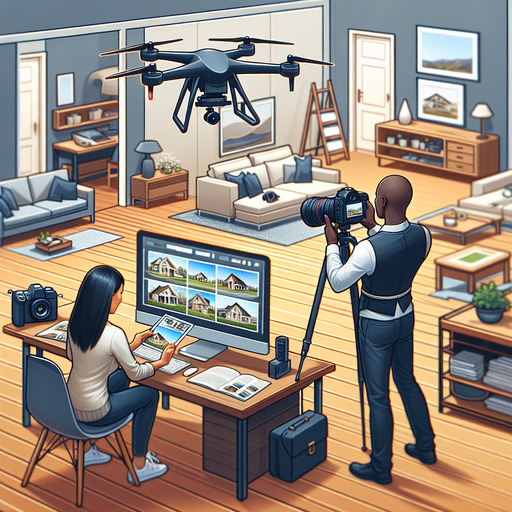
-
Table of Contents
- Mastering Real Estate Photography: Tips, Techniques, and Tools
- Understanding the Importance of Real Estate Photography
- The Role of Real Estate Photography in Selling Properties
- Essential Real Estate Photography Tips
- Advanced Techniques: Real Estate Drone Photography
- Case Study: The Impact of Drone Photography
- Choosing the Right Real Estate Photography Equipment
- Real Estate Photography Editing: Enhancing Your Images
- Example: Transforming a Dull Image
- Pricing Your Real Estate Photography Services
- Statistics: Pricing Trends in Real Estate Photography
- Conclusion: Elevate Your Real Estate Listings with Professional Photography
- Questions and Answers
Mastering Real Estate Photography: Tips, Techniques, and Tools
In the competitive world of real estate, first impressions are everything. High-quality real estate photography can make or break a property listing, influencing potential buyers’ decisions before they even step foot inside. This guide will explore essential tips, techniques, and tools to elevate your real estate photography game, ensuring your listings stand out in the crowded market.
Understanding the Importance of Real Estate Photography
Real estate photography is more than just snapping pictures of a property. It’s about capturing the essence and potential of a space, enticing buyers to envision themselves living there. According to the National Association of Realtors, 87% of home buyers found photos to be the most useful feature of online listings.
The Role of Real Estate Photography in Selling Properties
High-quality images can significantly increase the perceived value of a property. Listings with professional photos sell 32% faster than those without, highlighting the importance of investing in quality photography services.
Essential Real Estate Photography Tips
To capture stunning real estate photos, consider the following tips:
- Lighting is Key: Utilize natural light whenever possible. Open curtains and blinds to let in sunlight, and shoot during the golden hour for the best results.
- Declutter and Stage: Ensure the property is clean and staged to highlight its best features. Remove personal items to create a neutral space that appeals to a broad audience.
- Use a Tripod: A tripod ensures stability and helps achieve sharp, clear images, especially in low-light conditions.
- Capture Wide Angles: Use a wide-angle lens to showcase the full scope of a room, making spaces appear larger and more inviting.
Advanced Techniques: Real Estate Drone Photography
Drone photography offers a unique perspective, capturing aerial views that highlight the property’s surroundings and layout. This technique is particularly effective for large estates or properties with stunning landscapes.
Case Study: The Impact of Drone Photography
A real estate agency in California reported a 50% increase in inquiries for properties with drone footage, demonstrating the power of this innovative approach.
Choosing the Right Real Estate Photography Equipment
Investing in the right equipment is crucial for producing high-quality images. Consider the following essentials:
- Camera: A DSLR or mirrorless camera with a full-frame sensor is ideal for capturing detailed images.
- Lenses: A wide-angle lens (16-35mm) is perfect for interior shots, while a telephoto lens (70-200mm) can capture exterior details.
- Lighting Equipment: Portable flashes or LED panels can help illuminate darker areas, ensuring consistent lighting throughout the shoot.
Real Estate Photography Editing: Enhancing Your Images
Post-processing is an essential step in real estate photography. Editing software like Adobe Lightroom or Photoshop can enhance colors, correct distortions, and remove unwanted elements, resulting in polished, professional images.
Example: Transforming a Dull Image
Consider a dimly lit living room photo. By adjusting the exposure, contrast, and color balance, you can transform it into a bright, inviting space that appeals to potential buyers.
Pricing Your Real Estate Photography Services
Setting competitive pricing for your services is crucial. Consider factors such as the property’s size, location, and the complexity of the shoot. Offering tiered packages can cater to different client needs and budgets.
Statistics: Pricing Trends in Real Estate Photography
According to a recent survey, the average cost for real estate photography services ranges from $150 to $500 per property, depending on the market and service level.
Conclusion: Elevate Your Real Estate Listings with Professional Photography
Incorporating these tips and techniques into your real estate photography strategy can significantly enhance your listings, attracting more potential buyers and ultimately leading to faster sales. By investing in quality equipment, mastering editing skills, and understanding the market, you can set yourself apart in the competitive real estate industry.
For more insights on real estate photography, check out this comprehensive guide on Wikipedia.
Questions and Answers
Q1: What is the best time of day for real estate photography?
A1: The best time for real estate photography is during the golden hour, shortly after sunrise or before sunset, when the natural light is soft and warm.
Q2: How can I make small rooms appear larger in photos?
A2: Use a wide-angle lens to capture more of the room, and ensure the space is well-lit and decluttered to create an open, airy feel.
Q3: What are the benefits of using drone photography in real estate?
A3: Drone photography provides unique aerial views, showcasing the property’s surroundings and layout, which can attract more interest from potential buyers.
If you’re interested in learning more about our real estate photography services or have any questions, please contact us.